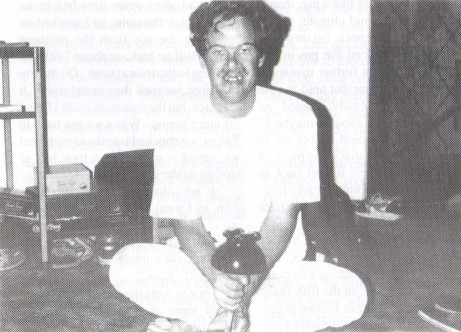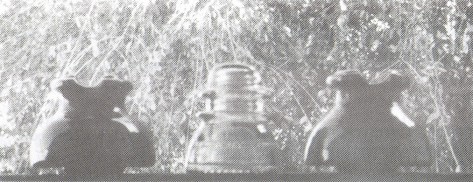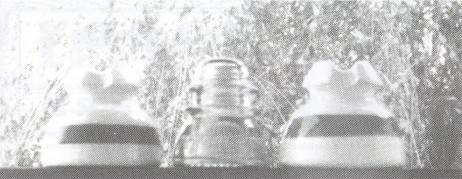Foreign Insulators
by Marilyn Albers
Reprinted from "Crown Jewels of the Wire", August 1993, page 6
This month, Jim Barton (Van Nuys, CA) concludes the story of his recent trip
to Taiwan. (See Foreign Insulators, June 1993 issue, page 8 for Part I)
It was Fu Ming that took the four of us to Kaohsiung for the afternoon. I've
never seen so many new skyscrapers under construction as I did in Kaohsiung. The
city is Taiwan's largest harbor, too, and boasts the world's largest drydock
facilities. We stopped at Kaohsiung's Grand Hotel, had lunch at a little street-side restaurant and visited a huge temple atop a hill overlooking Kaohsiung.
Finally, we made a stop at Kaohsiung Beach, where I saw two more of the
red-striped white insulators on an abandoned pole. Those insulators definitely
were the scarcest ones I'd seen in Taiwan. We came back to Tainan via Anping,
where the Dutch built a fort in 1653. Unfortunately, the fort was closed for the
day, and we never did return to it. Maybe next trip.
Saturday, October 3rd was
our last day in and around Tainan. I got up early that morning, determined to
take my last shot at getting one of those insulators on that brick wall at
National Chengkung University! I decided that I was going to push the buzzer and
wave a NT$500 note (about US$20) in front of anyone who answered my ring. So I
packed up my insulator collection pictures and the McLaughlin 19 in a plastic
bag. I decided to leave the camera behind this time, as I already had gotten pictures of the insulators in question.
I marched over to where the
insulators were and pushed the buzzer. The same little old Taiwanese man
answered my ring, but before I could even take out my wallet, he shook his head
and closed the gate again. I was highly disappointed. All I wanted was just that
one insulator without the wire. I tried the buzzer again, but no reply. I had to
be back at the hotel by nine o'clock, it was already after eight and I had a one
mile walk back to the hotel! I waited a short while, then decided I'd better say
a last good-bye to those beautiful insulators. But then, along came the little
old couple I met the day before. He was sweeping the sidewalk and she was riding
the scooter. They stopped and I took the time to explain about insulators and
insulator collecting (she spoke some English) and showed them my collection
pictures and the McLaughlin 19. They were highly interested in my hobby and
after talking to them, the man pressed the buzzer.
Once more, the gate opened
and there was the little old Taiwanese man. I don't know what the couple said to
him, but suddenly, the ice was broken! The Taiwanese man invited the three of us
inside the gate. I was shocked (so to speak) when he led us to a huge pile of INSULATORS! A pile some four feet
high! (And where was my camera? In the hotel room!) Most of the insulators were
big electric railway insulators, but the little old man reached down and brought
up two insulators just like the ones on the wall! The old couple who were
sweeping the streets lent a hand and within minutes, I had four brown insulators
and the two striped ones! I would have liked to stay longer, but I had to get
going. The three people found a box and some newspapers to wrap the insulators
in. The insulators all had metal pins attached, and as a result, the box was
heavy!
I tried to pay the people who helped me get those insulators, but they
refused the money, so with many thanks to both the old couple and the other
little old man, I lugged the insulators back to the hotel. By the time I got
back, I was sweating like a pig, thanks to Tainan's hot humid climate.
I decided
to check out my new insulators and noticed the pin in one was loose and upon
further investigation found the cement that held the pin in place could be
easily scraped out with my car keys! I thought maybe 15 minutes of work would
enable me to remove the pin and that's one piece of metal I wouldn't have to
cart back to Taipei the next morning. Pick, pick, scrape, scrape!! A few minutes
later the hotel room began to shake, then it rocked like a ship in a storm.
EARTHQUAKE! A pretty good-sized one, too, and the swaying and shaking was
exaggerated by our being on the fifth floor. Both Eddie and I began feeling
dizzy, but like the true California native I am, I went right back to what I was
doing the second the shaking began showing signs of dying down.
So it was back to the insulator, even though the hotel
room was still swaying. Pick, pick, scrape, scrape. The pin kept getting looser
but wouldn't come out! Pick, pick, scrape, scrape. The car keys weren't really
long enough to do the job. Pick, pick, scrape, scrape. It became a personal
vendetta!! Me against the insulator pin! Pick, pick, scrape, scrape. The pin
continued to loosen! I tried twisting the insulator free. No good! Pick, pick,
scrape, scrape. It got ridiculous. I finally gave up after a full two hours, but
that was only because it was II :30 p.m. and we had a 7:20 a.m. train the next
morning.
Eddie proved to be better than any alarm clock; he woke me up the next
morning by turning on the lights and banging the toilet seat. This at 5:00 a.m.
-- he was lucky I didn't brain him with one of the insulators! After packing,
I had some spare time before we had to catch the train, so I worked on removing
the pin from the insulator again. Still no luck, so about 7:00 a.m. we went to
the train station. On the trip to Taipei, we took the coastal route. It was
nice, but the mountain route I found far more scenic. When we got back to
Taipei, we checked into the same hostel we stayed at earlier, then took lots of
clothes to the one-day laundry.
It was close to late afternoon by then, so I
went back to getting the pin out of that one insulator. More pick, scraping and
twisting. I even ran water down into the pinhole. Finally, the pin came out!
YEA!!
I began working at getting the pins out of some of the other insulators.
Only then did I realize that two of the brown ones had pins that could simply be
unscrewed! Had I known earlier, I could have saved four or five pounds before getting on the train. After
unscrewing the pin from one, I saw that its threads looked like they were made
to American specifications. On a hunch, I tried screwing a Whitall Tatum No.1
onto the pin. It fit! I began wondering if those two insulators had been
imported from Japan.
Wednesday, October 7 was our last day in Tainan. I
succeeded in taking the metal pins out of all but one of the insulators. That
evening, we made our last visit to the street market near the hostel, packed our
bags and caught the bus to Chiang Kai-Shek Airport for the 10 p.m. flight back
to Los Angeles. I was able to get all my insulators into my carry-on, and it
weighed a ton! And I had to carry them all through both airports! The flight to
Los Angeles was uneventful, and I got a good amount of sleep. Because we gained
a day by re-crossing the International Date Line, we experienced two "Wednesday
nights" in a row!
We got into Los Angeles on the second Wednesday night.
Going through U.S. Customs was an interesting experience with those insulators!
I was detained for some time while they looked through my carry-on in utter
amazement! After all, they were used to seeing people smuggling in drugs,
jewelry, guns, etc., and there I am brining in a bunch of old junk from
telephone poles! The poor guys probably didn't know what to think, and
eventually they let me back into the U.S. with my garbage. A friend of Eddie's
picked us up at the airport and took the four of us home.
I love Taiwan and
would someday like to go back for another visit. I also wanted to try to do some
research into insulator manufacturers and even try to visit a factory or two, but never really had a chance.

Jim holding the one insulator still possessing its pin!
But I thoroughly
enjoyed the trip, so much so that I consider the insulators I got to be just the
icing on the cake. When will I go again? Hopefully, sometime in the next few
years. Until then, I'll have many pleasant memories to go with the insulators.
As it turns out, the six insulators I got in Tainan were the only ones I
obtained on this trip. It was just as well, really, for I didn't bring that much
luggage to begin with, and any additional insulators might have had to go into
checked baggage, and the thought of airport luggage handlers playing football
with a suitcase full of insulators makes me cringe. In reality, once I got those
six, I didn't really look that hard to find line crews or abandoned insulators.
Taiwan is porcelain country all the way. I must have spent half the trip looking
at the telephone poles, I must have seen thousands of insulators, and nowhere
did I see a single glass insulator -- not one. I guess it's entirely possible that
a Hemingray 42 may be lurking around somewhere on a remote part of the island,
but I doubt it --- the first glass insulators in Taiwan may very well have come
from my own common insulator pile.
The most common insulators in Taiwan are
three or four styles of white porcelain fog bowls that are good-sized. I got
none of those myself, but fellow collector Daniel Van Beers went to Taiwan a
couple of months before I did and brought back a few of the fog bowls. I had an
opportunity to see them at his house once, and I will say that they are some of
the most beautiful porcelain pieces I've ever seen. They are used on primary
distribution lines throughout Taiwan. According to Daniel, there are no multi-parts anywhere on
the island; transmission lines use suspension discs, and all the fog bowls are
uni-parts. Secondary distribution lines and low-voltage lines use white spools
(when they're not merely wrapped around street lights).
An occasional pole shows
up that has brown porcelain insulators that are somewhat smaller than the fog
bowls. Daniel told me that most of those were imported from Japan; he showed me
an NGK he got from Taiwan. They come with other markings, also, and we'll get to
that in a few minutes. Brown porcelains are nowhere near as common as the white
fog bowls in Taiwan.
Rarer still are the small white porcelain insulators shaped
somewhat like British open-wire communication insulators. Most of the ones I saw
were on abandoned poles that were obviously once used for open-wire communication
lines. Most of those poles were along rural stretches of railroad or highway,
but there was that one in the middle of Tainan. (Never did relocate that one; I
was so busy trying to get the insulators from that brick wall some blocks away.)
Scarcest of ail are the white porcelain insulators with either a red or orange
stripe around them. During my whole trip I saw maybe a dozen or so of those, all
in Tainan or Kaosiung. The ones with the red stripe are more numerous than those
with orange, the term "numerous" being relatively speaking, of course.

Now I want to share with you some pictures of insulators I got from Taiwan and
their markings. The Hemingray 42 is there for size comparison.

I got two of
these brown porcelain insulators with this marking. I asked Daniel about the marking, and as I
suspected, these were manufactured in Japan and exported to Taiwan. These are
the ones with the pinhole threads designed to American specifications. In the
picture, one Seto is to the left of the Hemingray 42.
To the right of the Hemingray
42 is a similarly shaped brown porcelain with the marking shown below.
According to See, this is the logo for the Taiwan Power Company. This
insulator has a pinhole less than half an inch in diameter. I got one of these.

The fourth brown porcelain piece (the one I was unsuccessful in removing the
pin) is nearly identical in size and shape to the other brown porcelain pieces.
However, it had the marking below.

Actually, the marking on this particular insulator is somewhat blurred, but I
was familiar enough with it (from a page in Worldwide Porcelain Insulators that
Marilyn Albers was kind enough to copy and send to me when I asked about
insulators in Taiwan before I took the trip) that I could make it out. Also,
Daniel has a white fog bowl with this marking. This insulator was probably
manufactured in Taiwan.
I saved the best for last, however. I'm talking about
the two similar white porcelain insulators that are pictures with the Hemingray
42 for size comparison. (See following page). The one on the left has this marking just about the reddish stripe.

The marking is a dark blue in
color and smaller on the insulator than I've drawn it here.
But I think the
real gem is the similar white porcelain to the right of
the Hemingray 42. It has an orange stripe and a marking written in a brilliant
blue underglaze ink that's striking next to the orange stripe.

Both the above
insulators were obviously made by the same company, and they're identical in
shape. They were probably made in Japan and exported to Taiwan. Daniel agrees
with me on this assessment.

I saw the marking below on one of the insulators attached to the brick wall
in Tainan, but obtained no specimens. The insulator was the same or very similar
in shape to the two Kawamuras and has identical coloration to the Kawamura with
the red stripe.

Daniel told me he saw a number of the FK's in Korea. I've wondered if FK and
Kawamura might be related.
All the insulators bear underglaze ink markings. Most
of the ones I got are in NM to mint condition; one does have some chipping at
the base. The two Kawamuras have three skirts, and the four brown insulators
have two skirts, with the inner skirt extending slightly below the outer.
Other
than the above descriptions and speculations, I don't really know that much
about the insulators themselves. Daniel Van Beers provided some of the
information to me that I've written above (Thanks, Dan!). But if anybody else
could provide some additional information, that would be welcome by Daniel,
Marilyn Albers and myself. Readers?
| 